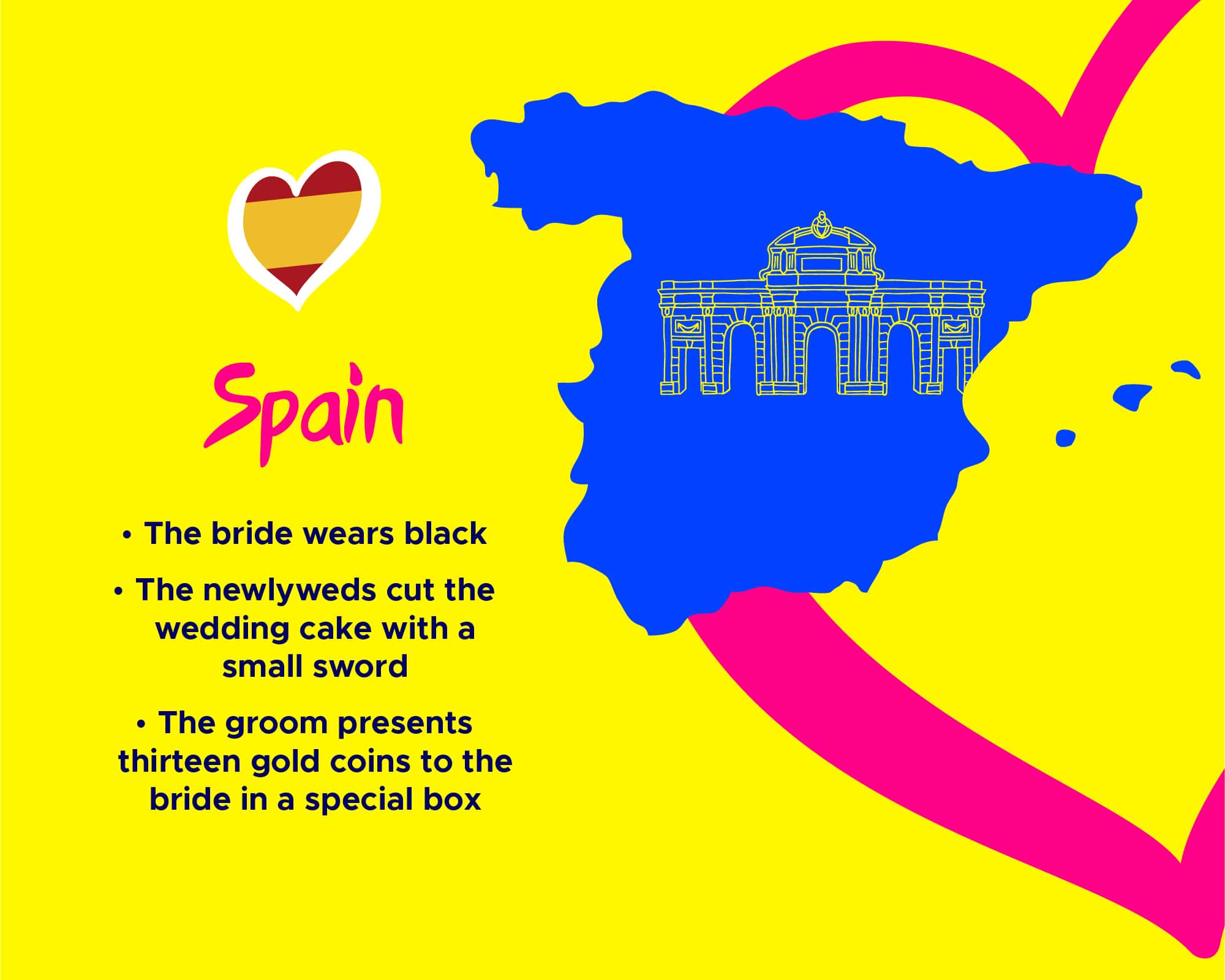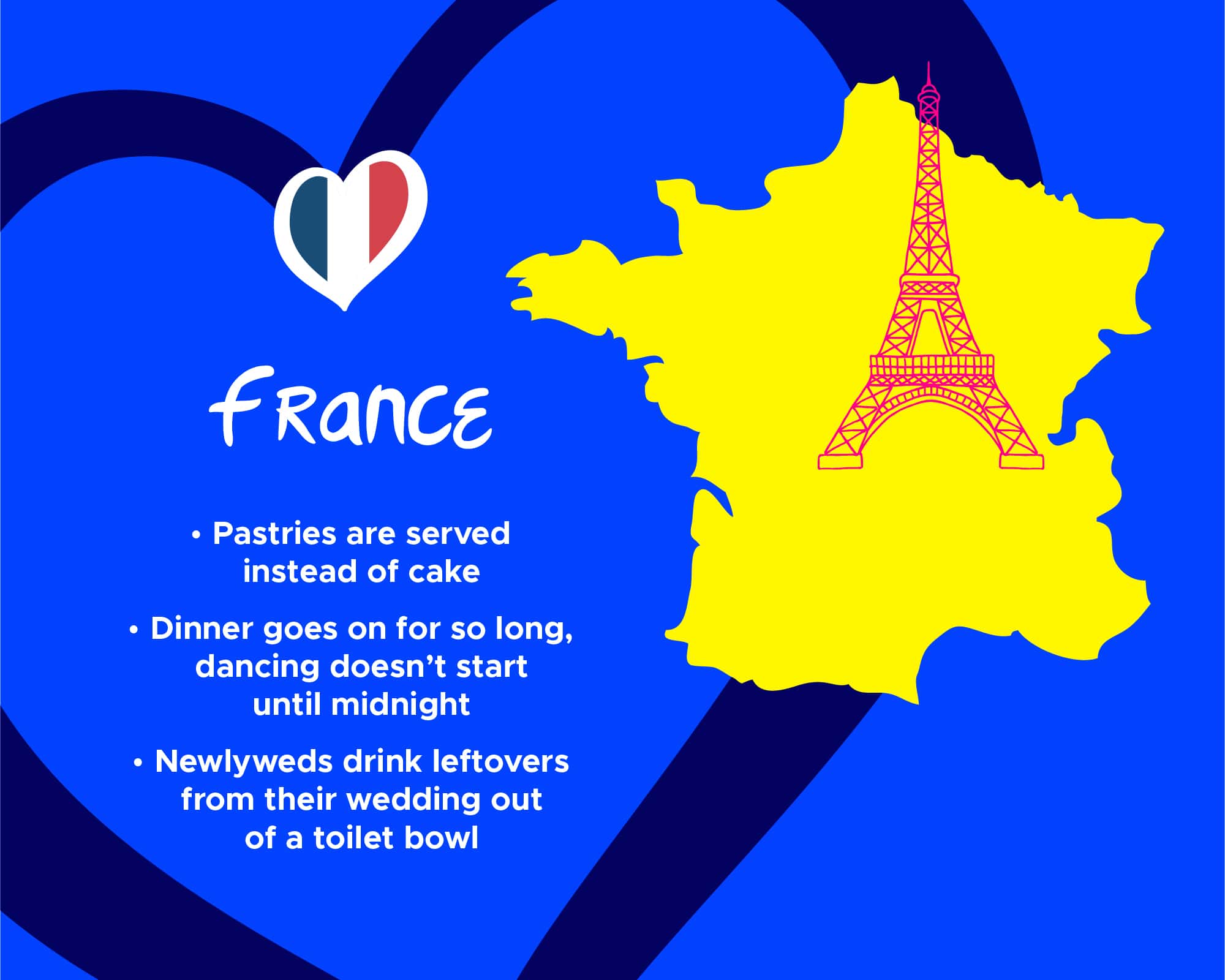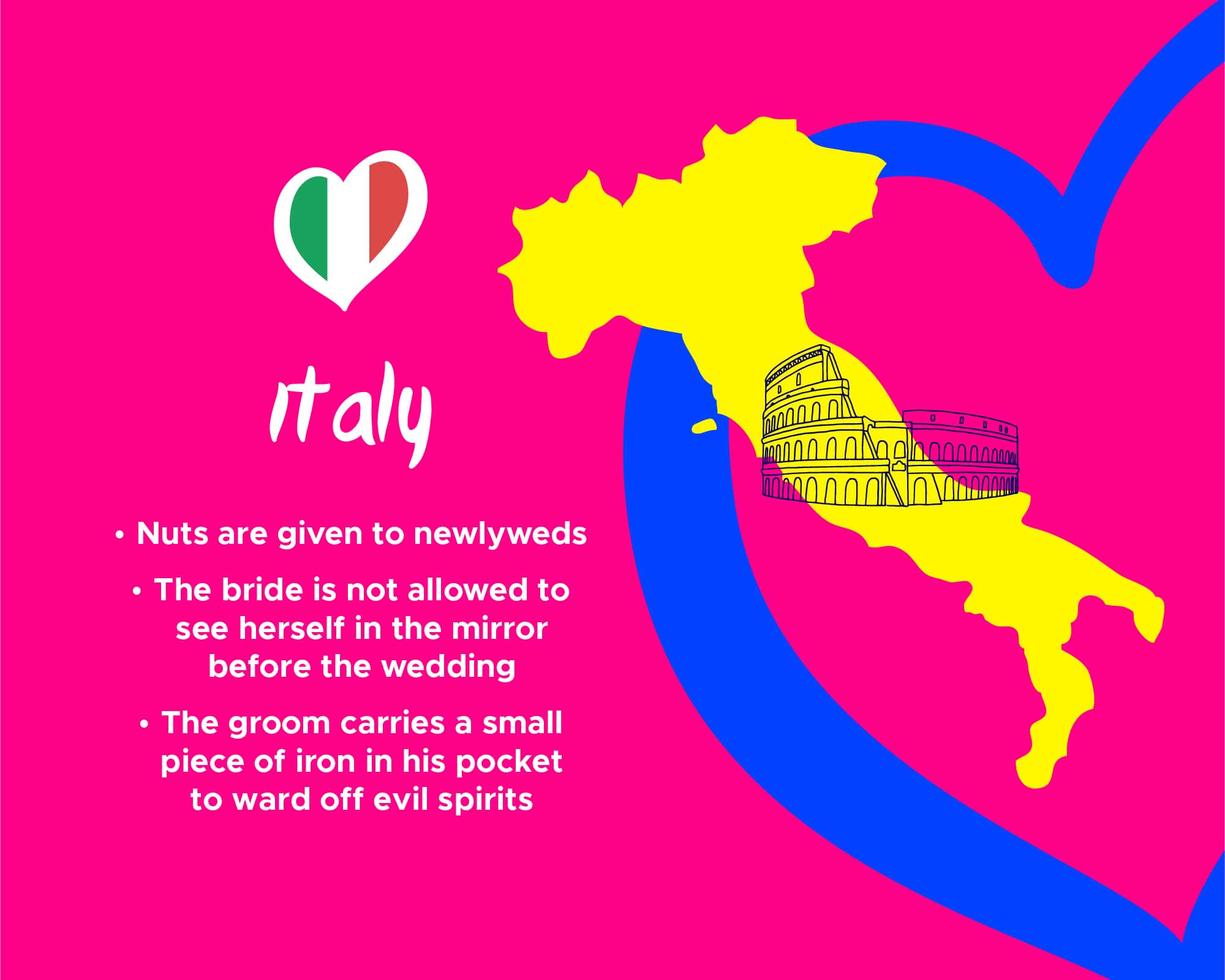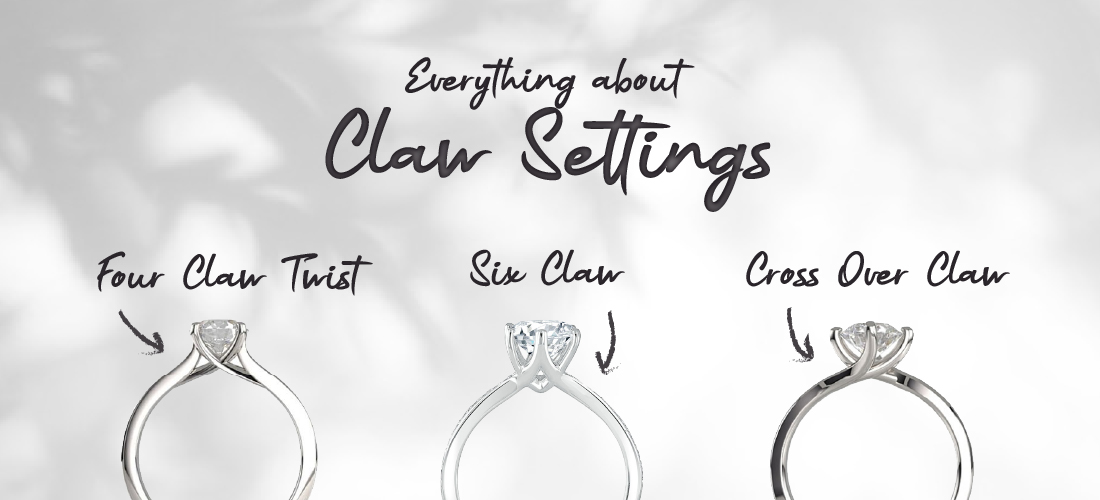
Wedding traditions are dramatically different around the world. From the type of cake served to the attire of the bride, you’ll be amazed at what happens on wedding days around the continent.
To celebrate Eurovision 2023 taking place in the vibrant city of Liverpool from 9th May 2023, engagement and wedding ring experts at Steven Stone have rounded up some of the most bizarre traditions from participating countries – including the “Big 5”.
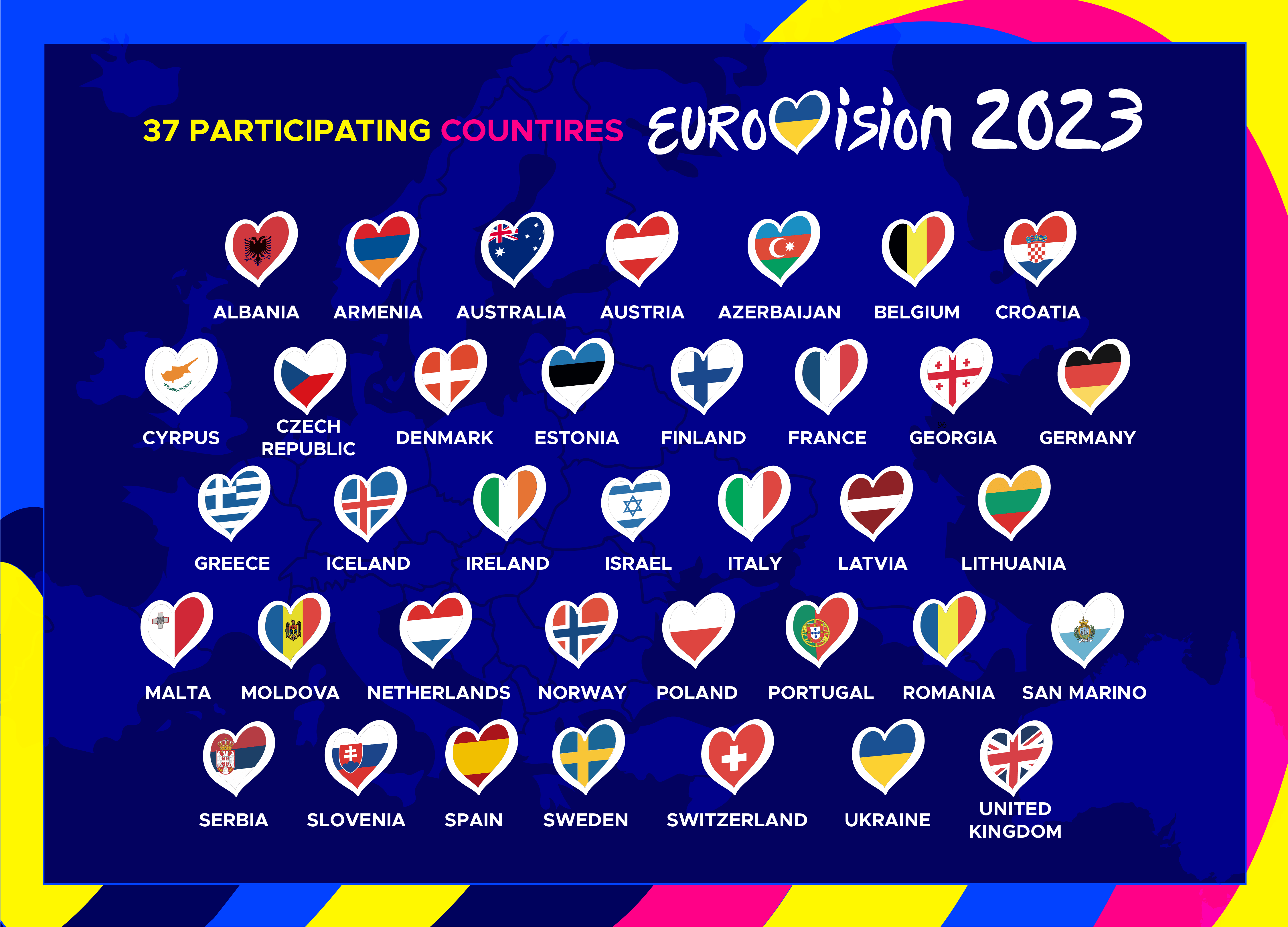
Who are the “Big 5”?

The “Big Five” (formerly “Big Four”) are the group of countries who make the biggest financial contributions to the European Broadcasting Union (EBU).
In 2000, a rule was created to allow those countries direct entry into the final of the Eurovision Song Contest regardless of their placing in the previous year’s contest, fear of relegation, or having to go through a semi-final round. With the return of Italy to the contest in 2011, the Big Four became known as the Big Five.
All five of thee nations have won the contest at least twice, with France being the only member of the Big Five to have never scored nul points.
France
Pastries are served instead of cake: France is famous for its incredible pastries, so instead of a fruit-filled wedding cake being the star dessert, at most French weddings, you’ll be served a Croquembouche – a beautiful dessert made up of small pastry balls stacked on top of one another.
Germany
The bride and groom use chainsaws: While still wearing their wedding attire, German newlyweds are sometimes known to saw a log into two pieces during the ceremony. This tradition is known as Baumstamm Sägen. As it’s a two person saw, Baumstamm Sägen symbolises the couples strength as they face challenges in their marriage.
Spain
The bride wears black: While it may seem a little strange, traditionally, a Spanish bride would wear a black lace gown and veil called a mantilla draped over her head and shoulders. The attire was designed to symbolise the devotion she has to her husband and addresses the ‘till death do us part’ vow. As for the veil, it was once thought that a bride who looked too beautiful would attract evil spirits, which is where the veil derived from.
United Kingdom
Old, new, borrowed, and blue: In the UK, this fun tradition is based on an old rhyme by an unknown English poet: “Something old, something new, something borrowed, something blue, and a silver sixpence in her shoe.”
On the day of the wedding, the bride must wear something old to represent the past, something new for the future, a borrowed item to symbolise the happiness given to the bride by the new husband, and finally something blue to ward off evil spirits. Nowadays, the final line about the sixpence is often practiced, however it historically referred to wealth.
Italy
Nuts are given to newlyweds: Many of us think of confetti as colourful bits of paper that get thrown at the newlyweds, however, in Italian “confetti” actually refers to sugared almonds that wedding guests receive as favours at the reception. These used to be thrown at the bride and groom, but have been replaced by coriandoli, the tiny scraps of paper.
Albania
Guns are fired to welcome the bride: Guns are integral to the Albanian wedding ceremony. This tradition has its roots in Albanian tribal culture, which was very much warrior-dominated. The guns – often automatic rifles – are fired when the bride arrives at the groom’s house. Quite the firework display!
Armenia
Putting money in the bride’s shoes: As the bride prepares for her special day, her brother will put some money inside her shoes. He has to do this without her noticing. This Armenian wedding tradition represents good luck for the bride-to-be.
If the bride has no brother, the closest male relative can take the role. This can be a cousin, an uncle, a nephew, and a family friend.
Australia
Guests are given special stones to hold: An Australian wedding ceremony might feature the tradition of a unity bowl. Upon arrival, guests are given stones which they are required to hold during the ceremony. When it’s over, guests then place the stones in a decorative bowl that the couple keep on display in their home – paying tribute to their friends and family who attended.
Austria
The bride is kidnapped: A common tradition still practiced today is the fetching of the bride. Traditionally the bride was taken from her parent’s house before the wedding. Her future husband would go from pub to pub searching for his bride, paying any unpaid tabs along the way. Finding his wife was proof that he was worthy of marrying her.
Azerbaijan
The bride writes on her shoes: The bride writes the names of her single friends under her shoes on the wedding day. According to the tradition, when the wedding is over, the person whose name is deleted will be the next bride.
Belgium
The bride carries two flowers with them: The bride will give one flower to her mother as she walks down the aisle. Once the vows are complete, she then presents the other flower to her new mother-in-law. This act is a symbol of unification and acceptance between the two families.
Croatia
Candles are carried down the aisle: During the processional ritual at a Croatian wedding ceremony, family members proceed down the aisle first, followed by bridesmaids and groomsmen who carry candles lit from one single flame that symbolises their union.
Cyprus
The couple are wrapped in scarves: Cypriot culture is rich in traditions. One of the wedding traditions of the inhabitants of the island is scarves and crowns – during which, guests wrap the pair in red scarves and place crowns on their heads.
Czech Republic
The lighting of the unity candle: Lighting a unity candle is a popular tradition during Czech weddings – this involves two candles being lit by either side of the couple’s parents before being used to light one larger central candle representing both families coming together as one unit.
Denmark
The bride wears red: Traditionally, a Danish bride will wear a white dress with a veil – though she will also wear something red. Symbolic of love, this is also to ward off evil spirits.
Estonia
Food is left out for ghosts: Left-over food must be left on the table and not cleared up till dawn, so that lost ghosts and wandering spirits can eat it.
Finland
Guests have to keep their jackets on: The guests are not allowed to take off their jackets until the groom takes off his.
Georgia
The unexpected first dance: Georgia has a variety of traditional dances. The first dance at a traditional Georgian wedding is qartuli, or the Georgian. The dance has a romantic content, where the woman has to move gently and expose her softness, and the man has to perform several sliding motions with his feet without moving his upper body.
Greece
The newlyweds dance for money: Once the wedding reception is in full swing, a traditional Greek wedding dollar dance will probably ensue. One of the many customs Greek Americans brought from Greece, this is a playful dance between the newlywed couple that is rewarded by guests tossing dollar bills onto the dance floor or pinning them onto the couple’s attire.
Iceland
The wedding cake is made of pastry: This tasty almond confection is commonly served at christenings, confirmations, and weddings. These crumbly, layered pastry wreaths usually stretch up into a small tower concealing wrapped pieces of candy.
Ireland
Luck ‘o the horseshoe: Celtic ceremonies featured a bride carrying an actual horseshoe with her during the ceremony, but modern interpretations of this Irish wedding tradition aren’t as literal.
Israel
Bride and groom separation: Some religious couples may not see each other a few days or even up to a week before the ceremony. They are often re-introduced to each other right before the reception, in a private photo session
Latvia
The groom carries the bride over a bridge: The groom is expected to carry his bride over a bridge, at least six times. Crossing the bridge symbolizes a conversion from status ‘mine’ and ‘yours’ to the status ‘ours’.
Lithuania
The couple is seated during the ceremony: Traditionally, during a Lithuanian wedding ceremony, couples are actually seated while the bridesmaids and groomsmen hold a red or white canopy over their heads. Modern couples tend to use arches or structures with these colors incorporated to give their arms a break!
Malta
Pigeons make an appearance: After the ceremony is over, its tradition not only to shower the Bride and Groom with dried rice and confetti, but also to let a few snowy white pigeons out of their cages too as a sign of congratulations!
Moldova
A plate is broken after dinner: One Moldovan custom is breaking a plate at the end of dinner. It’s believed to bring good luck and ward off evil spirits. The couple breaks a plate together, symbolizing their unity in facing any obstacles that may come their way.
Netherlands
There’s a wedding tree, instead of a guest book: Guests write down their good wishes on a paper leaf for the happy couple. The newlyweds read out the messages and then tie them to the tree with colourful ribbons. The tree is traditionally set up at the wedding reception and is placed adjacent to the table where the bride and groom are sitting.
Norway
There’s a cake filled with gifts: If you attend a wedding in Norway, you can expect to LOVE the cake. A traditional Norwegian wedding cake is called a kransekake, and is created by stacking iced almond cake rings on top of each other to create a cone shape. The best part? Inside of this hollow cake hides a selection of small gifts, like a bottle of champagne or wine.
At the party, the bride and groom will pick up the top ring of the cake and however many layers stick to it underneath is believed to be the number of children they will have.
Poland
There is A LOT of vodka: You can expect to drink lots of Vodka at a Polish wedding – it’s the most popular drink at Polish wedding feasts. There is no doubt that you’ll be able to find it on each wedding party table, as it will be used to raise a toast many times throughout the wedding.
Portugal
All night receptions: It is a Portuguese wedding tradition to have a reception that lasts until the next day. Depending on your venue of choice, the reception can end anywhere from 1am to 7am.
Romania
The Bride is kidnapped: In Romania, if the bride disappears, there’s no need to be alarmed as it doesn’t necessarily mean that she’s got cold feet. It’s actually tradition for the bride to be “kidnapped” by friends and family before the wedding. Just like role-play, to get the bride back, the groom has to pay her ransom, paying in romantic gestures or filling her glass with champagne.
San Marino
Mirrors are banned: In many Italian regions, the bride is not allowed to see herself in the mirror before the wedding. She can take a peek, but only if she first removes a glove or shoe.
Serbia
The groom goes apple shooting: This is a very special Serbian wedding tradition that is still practiced in rural regions. An apple is hanged at the bride’s house, on a tree. The groom has to shoot the apple and only when it falls from the tree, is he allowed to enter the bride’s home.
Slovenia
The Groom has to win the Bride in a series of games: When the groom arrives to get his future wife, he’s expected to overcome some challenges like door games. The bride-pick-up tradition is full of funny games where the groom proves his love for his bride.
Sweden
Tiaras are swapped for flower crowns: In Sweden, you’re unlikely to see a veil or tiara as the bride will always opt for a beautiful flower crown. Traditionally, a flower crown would feature a sprig of myrtle to symbolise love.
Now a common headpiece worn by bohemian brides, flower crowns have become a popular accessory around the world.
Switzerland
The newlyweds march through a tunnel: When the newly married couple emerges from the church or registry office, they “walk the gauntlet” between two rows of friends, all wearing matching outfits.
Ukraine
Bread is served instead of cake: In lieu of a traditional wedding cake, Ukrainian wedding receptions serve korovai – an intricately woven bread made of flour and decorated with flour figurines. It can have anywhere from one to five tiers. This bread is representative of the Ukrainian community and their blessing of the marriage.

If you’re looking for some jewellery inspiration, why not take a look at our full collection? Whether you’re after a necklace or some diamond earrings, we’ve got you covered. We also have a vast range of engagement and wedding rings.
If you don’t see anything that takes your fancy, we also offer a bespoke service, where our designers will create a unique piece of jewellery that ticks all the boxes.
Follow us on our socials
Pop over to our social platforms to keep up to date with Steven Stone’s latest jewellery content and news.


